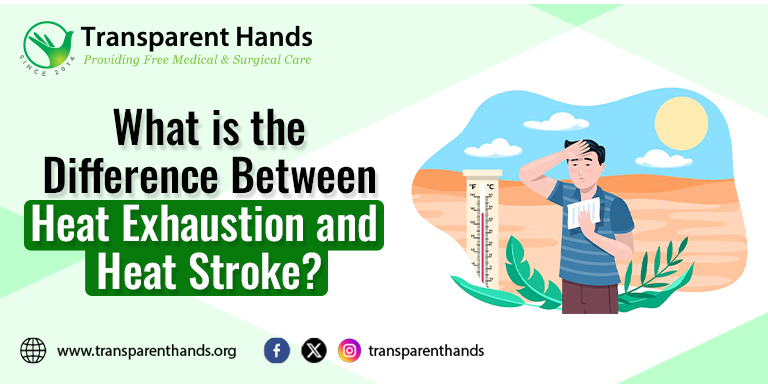What is the Difference Between Heat Exhaustion and Heat Stroke?

Every year, thousands of cases of heat stroke are reported in Pakistan. Heat exhaustion and heat stroke are illnesses that are caused by a long exposure to extreme heat. Understanding the early warning signs of heat stroke and heat exhaustion is necessary.
This blog will explore heat stroke vs heat exhaustion, covering the main differences. It will explain how one is more dangerous than the other, including how they can be treated effectively. In both scenarios, a medical team will need to be called to avoid critical issues but certain steps can be taken during the wait.
Heat Stroke Vs Heat Exhaustion
Heat exhaustion is a mild to moderate heat-related illness. It occurs due to elevated temperature, humidity, dehydration, and prolonged exposure to sunlight. However external temperatures need not be extremely high for the body to demonstrate an adverse reaction. Sometimes people suffer from heat exhaustion simply by going to the gym. This is because heavy physical exercises, combined with high levels of humidity caused by sweating, can have the same impact as high external temperatures and humid environments. People suffering from heat exhaustion will experience excessive sweating, fainting, and weakness.
When heat exhaustion goes untreated for a long time it becomes heat stroke which is a life-threatening complication. Organ damage, stroke, and brain damage can occur if immediate medical attention is delayed. Learn more about heat stroke vs heat exhaustion below!
Heat Stroke
Heat stroke is a heat-related illness that occurs due to the rise in temperature and impaired homeostasis failing to control the internal temperature of the body. It demands serious medical attention and STAT treatment.
The natural temperature of the human body is 35°C and can go up to 36°C. On the Fahrenheit scale, this shows up as 95°F to 96°F. When the basal body temperature begins to climb, the human body can try to adjust itself by letting out the excess heat in the form of sweat. But if the body is dehydrated i.e. it doesn’t have enough fluid to begin with, it can become difficult for it to readjust the basal body temperature. That is why the body needs more fluids and water during exercise and in high-heat environments.
When the signs of heat exhaustion are ignored, and no attention is given, it escalates into heat stroke which is a deadly condition.
How to Diagnose Heat Stroke?
Your body will give you prominent signals when your internal body temperature is elevated from the normal level, such as fever, unconsciousness, and a high pulse rate. If the body is unable to bring the basal body temperature down, eventually the internal body temperature will climb to 40°C or above (104°F or more). At this temperature, internal organs can stop functioning properly. This means you are experiencing heat stroke and it is considered a medical emergency.
Your doctor will develop a diagnosis and treatment plan based on your symptoms, and run some tests for a confirmed diagnosis.
For heat stroke and the co-morbidities associated with it, the following diagnostic tests are usually performed.
Blood Test
A blood test is performed to check the fluctuation in sodium and potassium levels.
Kidney Function Test
Kidney function tests need to be done to rule out any kidney related complications associated with heat stroke.
Urine Test
Dark yellow urine indicates severe dehydration. A urine test is essential in heat stroke.
Muscle Mobility Test
Due to heat stroke, a person tends to lose consciousness and experience impaired activity of limbs. This requires a muscle mobility test to be done.
Imaging and X-ray
Lastly, to rule out the chances of internal organ damage, and internal bleeding imaging studies are done.
What Are The Signs of Heat Stroke?
Heat stroke can be fatal. It greatly affects people older than 50 years. Athletes and people who spend most of their day in direct sunlight need to take extra precautions.
When learning about heat stroke vs heat exhaustion, keep in mind that both conditions can occur due to prolonged exposure to sunlight. There are a few symptoms that can help determine if a person is going through heat stroke. If you or someone you know is experiencing more than four of these signs, please get medical attention immediately.
- Rise in Body Temperature: If a fever climbs to over 104°F or 40°C, this is cause for serious concern. It demonstrates that the internal body is unable to cool down.
- Dry and Hot Skin: Due to a lack of internal fluids, the body employs all available fluids for the purpose of reducing the effects of heat. So, the person’s skin would look dry and hot.
- Confusion and Delirium: At this stage, a person might appear to be very confused and anxious. Their speech might be slowed down or slurred altogether.
- High Pulse Rate: As the body tries harder and harder to cool down by sending blood to the extremities to create sweat, the person’s heart rate might climb up.
- Nausea and Vomiting: The digestive tract is unable to function properly under high heat. The body also tries to reduce the heat-producing process of digestion. So, the person might start throwing up to cool down.
- Headache: Along with the nausea, the person might report a headache.
- Loss of Consciousness: As internal organs begin to fail and the body spends all of its energy on cooling down, the person might faint.
What Is the First Aid for Heat Stroke?
It is important to know the basic first aid for a heat stroke. This is because the immediate tools and steps are simple and easy to practice. And before the arrival of a medical team, these few things might just save the affected person’s life:
- Fanning: With any object available, fan the affected person’s body and face especially over their mouth and nose. This will help existing sweat evaporate quickly and cool off some of the heat.
- Move the Person: Take the person to a colder environment, such as an air-conditioned room.
- Apply Ice: Hold blocks of ice (covered with cheesecloth or a muslin rag) over the affected person’s body or prepare an ice-cold bath for them to sit in. You can also hold an icy wet towel over their neck and forehead or spray them with a garden hose.
It’s important to note that a medical team needs to be contacted immediately. These are just the things that you can do before they arrive.
What is The Proper Treatment for Heat Stroke?
The proper treatment for a heat stroke is to be performed by the medical team. It’s important that those around the affected person quickly call an ambulance and do not take it upon themselves to perform the complete treatment.
What is The Fastest Way to Recover From a Heat Stroke?
The fastest way to recover from a heat stroke involves understanding what can quickly be done to prevent damage to internal organs. Cold immersion is advised for heat stroke.
Maintaining hydration and the intake of electrolytes to restore salt levels is also beneficial if someone is experiencing mild to moderate heat stroke.
Heat Exhaustion
Loss of salts, water, and electrolytes due to excessive sweating is called heat exhaustion. It is one of the heat related illnesses that occur during heat waves or when one is in the sunlight for long hours.
In contrast to heat stroke, heat exhaustion is not fatal. Rather it is the first step that leads to heat stroke. Medical attention is crucial in such cases as heat exhaustion can become life-threatening if treatment is not provided.
What Are the Signs of Heat Exhaustion?
When understanding heat stroke vs heat exhaustion, it’s important to note the differences between their signs and symptoms. In heat exhaustion, the following things are likely to happen:
- Excessive Sweating: As the body attempts to cool down, it starts using all of its fluids to sweat, making the affected person perspire heavily.
- Pale and Clammy Skin: When the body starts sweating excessively, the skin may appear pale and clammy.
- Dark Yellow or Green Urine: Because the body’s fluids have been used up, the color of the affected person’s urine will be much darker.
- Headache: The affected person will usually report a headache.
- Exhaustion: Much like the name, heat exhaustion causes the person to become weak with fatigue.
- Weak Pulse: Their pulse will become weak and slow.
- Dizziness: The person will begin to lose balance.
- Nausea and Vomiting: As the body continues to try to cool off the high internal temperatures, the affected person might feel nauseous and start vomiting.
- Muscle Cramps: When it starts getting worse, the patient might report painful spasms and cramps in their muscles.
What Is the Best Way to Treat Heat Exhaustion?
- Move to a cooler place: The person affected by heat exhaustion can look for a shady area or go to an air-conditioned room.
- Rest: The affected person should sit or lie down so the body does not expend more energy on movement.
- Cold Water: The person should drink large amounts of cold water. This will immediately give them more fluid to convert to sweat. Consume products like oral rehydration salts to restore the balance of electrolytes. Caffeinated and alcoholic drinks must be avoided.
What is the First Line Treatment for Heat Exhaustion?
The first step in both heat exhaustion and heat stroke is to move the affected person to a cooler place. Remove tight and extra layers of clothing and start spraying cold water to lower body temperature. The affected person should be offered cold water or drinks rich in electrolytes.
How Long Does Heat Exhaustion Last?
Patients usually recover from heat exhaustion between 24 and 48 hours. It is recommended that if the symptoms of heat exhaustion do not improve within an hour of following the above steps, then a medical care provider should be called immediately.
In this article on heat stroke vs heat exhaustion, we’ve learned that both of these conditions are dangerous and should be addressed immediately. With timely diagnosis and effective treatment, one can recover fully with time. The key is to keep an eye out for the early signs and seek medical attention.
Transparent Hands’ Role in Tackling Heat Stroke and Heat Exhaustion
Since many underprivileged communities lack access to proper medical care and information to prevent and manage these conditions, our medical teams have been raising awareness about them by holding preventive healthcare sessions at free medical camps in Pakistan. In addition, we also distribute oral rehydration salts among deserving patients in Pakistan. Donate now to play your part!











Leave Your Comments